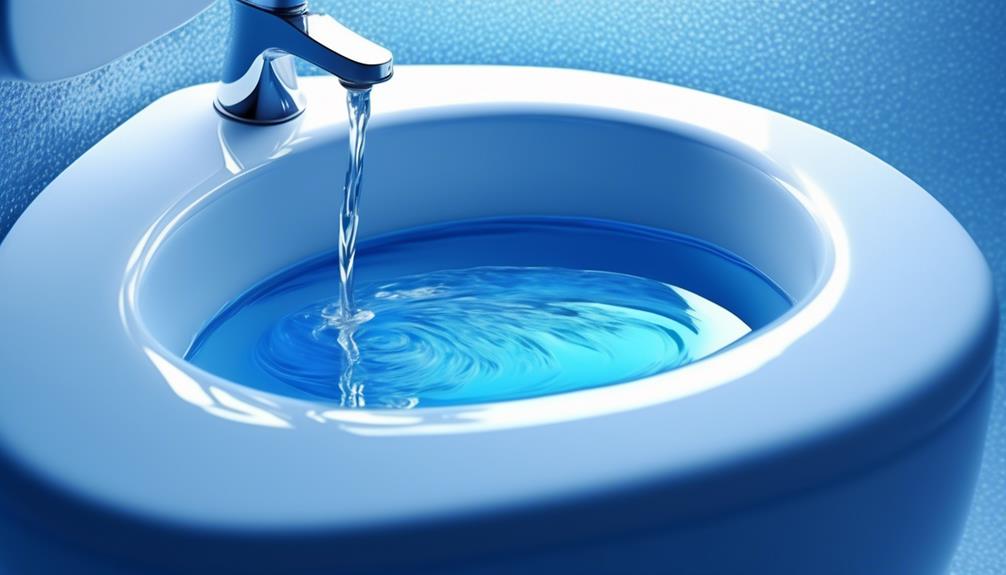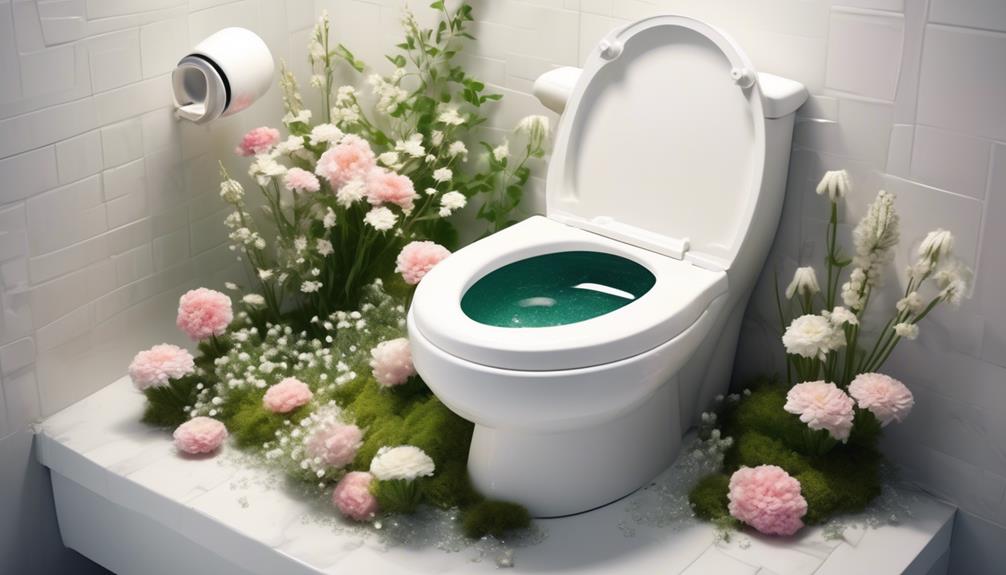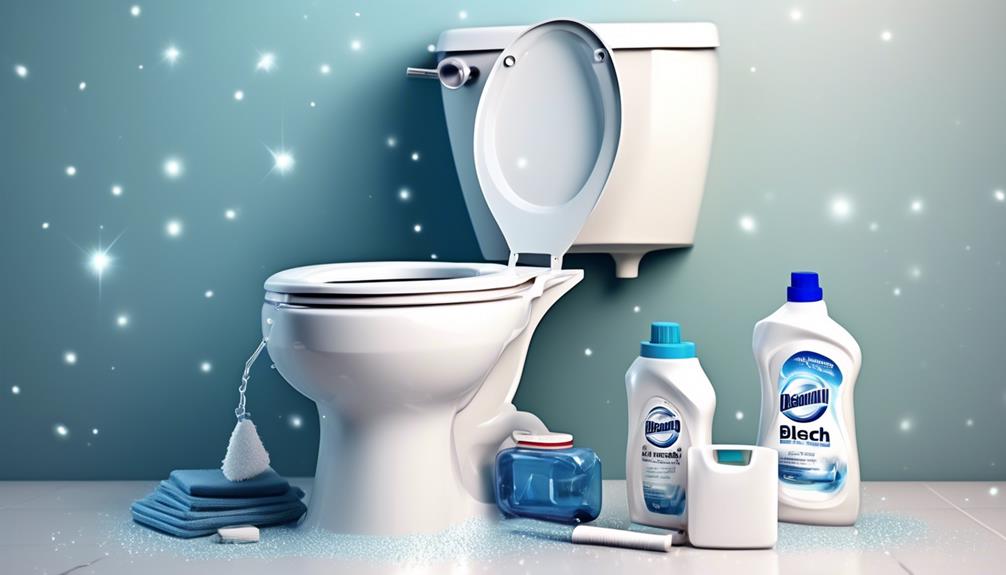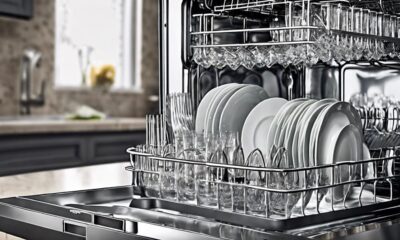Beginners Guides
Bleach in Toilet Overnight

We have all dealt with the annoyance of persistent toilet stains that refuse to come off no matter how hard we try to scrub. Picture waking up to discover those stubborn stains have magically disappeared after placing a common household item in the toilet overnight.
It may seem too good to be true, but there's a method to this magic that we're about to uncover. Stick around to learn how a common household product left in the toilet overnight can work wonders and save you from the hassle of constant scrubbing.
Key Takeaways
- Safety precautions should be followed when using bleach in the toilet overnight, such as wearing protective gloves and ensuring proper ventilation.
- Overnight bleaching can significantly improve the cleanliness and freshness of the toilet bowl, effectively removing stubborn stains and eliminating foul odors.
- Bleaching the toilet overnight saves time and provides a more thorough and deep clean compared to regular methods, reducing the need for extensive scrubbing.
- There are alternative, natural cleaning options for toilet maintenance, such as hydrogen peroxide, vinegar, and baking soda, which contribute to a healthier and more sustainable lifestyle.
Safety Precautions
When using bleach in the toilet overnight, it's crucial to follow safety precautions to ensure the well-being of both ourselves and the environment.
Firstly, it's essential to wear protective gloves and ensure proper ventilation in the bathroom to minimize direct contact with the bleach fumes, which can be harmful to the respiratory system.
Additionally, it's important to avoid mixing bleach with any other cleaning products, as this can lead to hazardous chemical reactions, releasing toxic gases that pose serious health risks.
Another vital safety measure is to carefully read and follow the instructions on the bleach product to prevent any potential mishaps.
When disposing of the bleach solution after use, it's essential to be mindful of its environmental impact. Diluting the solution with plenty of water before flushing it down the toilet can help minimize its impact on the environment.
Benefits of Overnight Bleaching

After leaving bleach in the toilet overnight, we noticed a significant improvement in the cleanliness and freshness of the bowl. The cleaning effectiveness of the bleach was remarkable, as it effectively removed stubborn stains and eliminated foul odors, leaving the toilet sparkling clean and pleasantly scented.
This time-saving solution allowed us to simply pour the bleach before going to bed, and wake up to a thoroughly cleaned toilet without the need for extensive scrubbing or multiple cleaning sessions.
The overnight bleaching process not only saved us time and effort but also provided a more thorough and deep clean compared to regular cleaning methods. The bleach had ample time to work on tough stains and bacterial buildup, resulting in a noticeably cleaner and more hygienic toilet bowl.
Additionally, the continuous exposure to bleach overnight helped prevent the accumulation of new stains, reducing the frequency of intensive cleaning sessions.
Step-by-Step Guide
To achieve optimal results when bleaching a toilet overnight, begin by thoroughly cleaning the toilet bowl using a toilet brush and a cleaning solution. This step is crucial as it helps to remove any existing dirt, grime, or mineral deposits, allowing the bleach to work more effectively.
Once the toilet bowl is clean, carefully pour the bleach directly into the bowl, making sure to coat the entire surface, including under the rim. It's important to use caution and avoid splashing the bleach, as it can cause skin and eye irritation.
After applying the bleach, let it sit undisturbed in the toilet bowl overnight. The extended exposure time allows the bleach to thoroughly disinfect and whiten the bowl, tackling any lingering stains and odors.
In the morning, flush the toilet to rinse away the bleach and reveal a sparkling, sanitized result.
The benefits of this application technique are manifold. By allowing the bleach to sit overnight, it has ample time to penetrate and break down tough stains, resulting in a cleaner and fresher toilet. Additionally, the disinfecting properties of bleach help to eliminate harmful bacteria and germs, promoting a healthier environment.
This step-by-step guide ensures that the bleach is applied effectively, maximizing its cleaning and sanitizing potential.
Alternatives to Bleach

Consider using hydrogen peroxide as a non-toxic alternative to bleach for disinfecting and whitening your toilet bowl. Hydrogen peroxide is an excellent natural alternative because it breaks down into water and oxygen, making it eco-friendly and safe for the environment. It possesses strong oxidizing properties, effectively killing germs and bacteria while removing stains without harming the environment.
Another natural alternative is vinegar, which can be used to remove stains and eliminate odors. It contains acetic acid, a powerful disinfectant that can effectively kill bacteria and viruses.
Additionally, baking soda is a gentle yet effective eco-friendly option for cleaning and deodorizing your toilet bowl. It can be used alone or in combination with vinegar to create a fizzy, cleaning reaction that helps to scrub away grime and stains.
These natural alternatives not only provide effective cleaning but also contribute to a healthier and more sustainable lifestyle. By opting for eco-friendly options, we can reduce our environmental impact while maintaining a clean and hygienic home.
Maintenance Tips

When maintaining a clean and hygienic toilet bowl, it's important to implement regular cleaning routines and use eco-friendly alternatives for disinfecting and whitening. To effectively tackle toilet stains and keep the bowl fresh, consider incorporating these maintenance tips into your cleaning regimen:
| Cleaning Solution | Ingredients | Benefits |
|---|---|---|
| Vinegar Solution | White vinegar and water | Natural disinfectant and deodorizer |
| Baking Soda Paste | Baking soda and water | Gentle abrasive for removing stains |
| Lemon Juice Solution | Lemon juice and water | Natural whitener and fresh scent |
Regularly using these eco-friendly cleaning solutions can help in preventing and removing stubborn toilet stains, keeping your toilet bowl clean and fresh without harsh chemicals. Additionally, incorporating these maintenance tips into your cleaning routine promotes a healthier and more sustainable approach to toilet care. By embracing these eco-friendly alternatives, you can effectively maintain a hygienic toilet bowl while minimizing environmental impact.
Frequently Asked Questions
Can Using Bleach in the Toilet Overnight Damage the Toilet Bowl or Plumbing?
Using bleach in the toilet overnight can potentially damage the toilet bowl or plumbing. It's important to be cautious with cleaning products and follow proper toilet maintenance guidelines.
Harsh chemicals like bleach can corrode the toilet's surface and harm the plumbing if left for an extended period. Regular maintenance and using appropriate cleaning products can help prevent any damage to the toilet bowl or plumbing.
Is It Safe to Use Bleach in the Toilet Overnight if There Are Pets or Small Children in the Household?
Like a cautious navigator, we prioritize safety precautions with pets or small children around. When using bleach in the toilet overnight, we need to consider the potential risks.
It's crucial to store cleaning products out of reach, use childproof locks, and ensure proper ventilation. Alternatively, one can use natural cleaning agents like vinegar or baking soda.
Our commitment to safety ensures a clean and secure environment for all.
Will Overnight Bleaching Affect the Septic System or the Environment?
Overnight bleaching can have a significant impact on the septic system and raise environmental concerns. The chemicals in bleach can disrupt the natural balance of bacteria in the septic tank, affecting its ability to break down waste.
Additionally, when bleach leaches into the environment, it can harm aquatic life and ecosystems. It's crucial to consider these factors and use bleach responsibly to minimize its negative effects on the septic system and the environment.
How Often Should Bleach Be Used in the Toilet Overnight for Best Results?
For best practices, the frequency of bleach use in the toilet overnight varies.
We've found that using bleach once a week can help maintain cleanliness and prevent stains.
However, it's important to avoid overuse, as it can damage the toilet and impact the environment.
Always follow manufacturer guidelines and consider alternatives for eco-friendly cleaning.
Balancing effectiveness with environmental impact is key to mastering toilet cleaning.
Are There Any Potential Health Risks Associated With Using Bleach in the Toilet Overnight?
Potential hazards may arise from using bleach in a poorly ventilated area. Proper ventilation is crucial to minimize exposure to harmful fumes.
It's important to be aware of the potential health risks associated with bleach fumes. Adequate ventilation helps to reduce the concentration of fumes in the air, which can protect individuals from potential respiratory and other health issues.
Understanding the importance of proper ventilation is essential for maintaining a safe environment when using bleach.
Can Bleach in the Toilet Overnight Damage the Corner Toilet Rough-in?
Leaving bleach in the toilet overnight can potentially damage the corner toilet rough-in. The harsh chemicals in bleach can corrode and degrade the materials of the rough-in, leading to leaks and other issues. It’s important to use caution when using bleach in toilets, especially around the corner toilet rough-in.
Will Bleach in the Toilet Overnight Damage the Carpet?
Leaving bleach in the toilet overnight will not damage the carpet unless the toilet overflows. Bleach can cause carpet discoloration and weaken its fibers. It’s always best to keep the toilet lid closed. Additionally, regular deep cleaning and maintenance can extend how long carpet lasts.
Conclusion
In conclusion, 'a stitch in time saves nine.'
Overnight bleaching can save you time and effort in keeping your toilet clean and sanitized.
Remember to follow safety precautions, enjoy the benefits of a sparkling clean toilet, and consider alternative cleaning methods for a more eco-friendly approach.
With regular maintenance, your toilet will stay fresh and hygienic for you and your family.
Happy cleaning!
- About the Author
- Latest Posts
Introducing Ron, the home decor aficionado at ByRetreat, whose passion for creating beautiful and inviting spaces is at the heart of his work. With his deep knowledge of home decor and his innate sense of style, Ron brings a wealth of expertise and a keen eye for detail to the ByRetreat team.
Ron’s love for home decor goes beyond aesthetics; he understands that our surroundings play a significant role in our overall well-being and productivity. With this in mind, Ron is dedicated to transforming remote workspaces into havens of comfort, functionality, and beauty.
Beginners Guides
Design Trends That Are Huge For 2023

2023 is just around the corner, and several trends are beginning to emerge. Here’s my take on what we can expect in the coming years: Neutral color schemes are becoming increasingly popular in the design industry. Colored concrete is a favored option, along with gentle curves and striking typography. The black lives matter movement will shine a spotlight on marginalized communities, specifically black and brown individuals. This will greatly influence the portrayal of these groups in design.
Muted Color Palettes Will Dominate in 2023
In the coming years, muted color palettes will take over the visual landscape. These palettes are characterized by a low saturation level and tend to convey a sense of security and safety. They have a natural and organic feel. To create a balanced design, muted colors are often combined in design with other elements like black, white, or complementary colors; visuals should be brightly colored, but they can also be used in muted colors to maximize impact. Graphic designers are also fond of abstract shapes. Geometric shapes in soft pastel tones are great for contrasting muted backgrounds. On the other hand, geometric shapes with hard edges make for more eye-catching visuals.
Although muted color palettes are not new, they are becoming more popular for variety reasons. They are easy on the eyes, and they can be calming. They also have low saturation, which makes them appear more subdued.
Colored Concrete Is a Popular Material
Colored concrete has many advantages and is currently a hot topic in design. It is becoming a favorite choice for floors, exteriors, and kitchens. It is strong and durable and will not show any marks or chips. It is also easy to source. It is one the top flooring trends in 2023. Whether you are remodeling your home or building a new one, colored concrete is a great choice for your project.
Colored concrete has many benefits. It is easy to use and comes in a variety of colors. It is also non-reactive. This makes it easier to apply the color and ensures that it remains vibrant. Because of its small particle size, it is easier to penetrate porous cementitious surfaces. The dyes used in concrete come as liquid dispersion or powders and are available in water-based and solvent-based options.
For projects that have high traffic, colored concrete is a great choice. It has few downsides compared to other options. It is very low maintenance and does not fade, which makes it an excellent choice for high-traffic areas. However, it does have some limitations and is not as flexible as concrete staining.
Bold Typography
Bold typography is an excellent way to emphasize important information without overwhelming the viewer. However, the use of this technique should be kept to a minimum. Incorporating too many words in bold style will cause online users to become disoriented. You should use bold typography to highlight six or fewer key words.
Bold typography is becoming increasingly popular for websites. More companies are using this style to make their websites look more modern and stylish. This style is part of the Neue Nou trend and works well for pages with short words. According to Monotype, this trend is a modern twist on the Art Nouveau style. This design style is reminiscent of the 1920s style, which featured decorative designs, embellished stroke endings and triangular or diagonal character shapes. It also features modern organic forms.
Bold fonts are especially effective for headlines. The bold style is also effective for content elements like jump lines. Online visitors can be guided to a page by bold buttons.
Soft Lines
Curved accents and furniture are one of this year’s most popular design trends. This trend is much easier to incorporate into your home that you might think. For example, you can convert a square opening into an arched one. The Inspired Room features before and after images to show you how to do it. Manufacturers are also adopting this trend, making more curved furniture and accents.
Another trend is the use of colors. Designers use various colors in their illustrations, backgrounds, or buttons. You can also use gradients to border elements. This trend also extends to linework. Lines can be used to delineate sections and headers and create a dynamic grid for the entire webpage. You can also use linework illustrations to create an abstract or figurative effect. To achieve the desired effect, you must use the correct weight of the line.
Frasurbane
Frasurbane is one of the design styles that are popular in the interior design world. This interior design style was popularized in the 1990s. It is characterized by muted colors and carefully placed design elements. This style aims to balance the idea of stuffy grownup refinement with a sense of youthful urban hipness. It’s a mixture of minimalism and culture-loving show-off, but the combination can come across as pretentious.
Frasurbane is a combination of modern design and high culture from the 90s. Featuring muted colors and minimalist details, this style exemplifies the affluence of a younger generation. This look is closely related to Gen X, a group that became financially independent in their twenties.
If you want to make a mark in the design world, try a Frasurbane look. This style is based on Gen Xers’s urban lifestyles and features traditional and modern elements. Examples include a grand piano, a modernistic fireplace, and a statement column.
Quotes
Quotes are becoming a popular design trend these days. Individuals should use serif fonts to express their feelings. Some designs include the quote along with a photo of the person who said it. Some quotes refer to a historical figure.
Quotes are not only used on blogs but in social media as well. They can be used to tease users into reading more. Zendesk, for example, uses quotes from its blog posts as a teaser to promote its website. Another example is Asana which uses quotes from blog posts in conjunction with a brand image. It is predicted that this trend will continue into 2023.
Design is more than aesthetics. It can impact the way people feel about a product or company. For example, Dr. Edwin Land, a scientist from the United States, invented the instant camera Polaroid.
Data Visualizations
Data visualizations are a major design trend today. These graphics help to illustrate important information by presenting it engagingly. But for these to be effective, designers need to select the right sources of data. Machine learning and AI are changing the way we interact with data. Virtual reality also offers visual controllers that enable us to explore data sets within a virtual environment.
In data visualizations, custom styles and shapes are used to express information. These shapes and styles can be customized to meet different needs. Data visualizations can be used to represent both qualitative and quantitative information. Data visualizations are an effective tool for communicating information. Designers are constantly looking for new ways to make them more compelling.
Data visualizations allow businesses to tell new stories. They can also explain trends, associations, and clusters. Data visualization can also be used for explaining the corporate change.
Art Deco Accents
Art déco is a style that was popular in the 1920s and 1930s. It was inspired by ancient Egyptian, Mayan and Aztec art, as well as Art Nouveau. Art déco is characterized by geometric shapes and bold colors, with exotic textures.
Geometric Tiles
Geometric tiles are a big trend for 2023. These tiles have a geometric design, rather than being square or round. You can use them in your kitchen or bathroom, and they come in so many different colors and shapes you’re sure to find something that works for your space. They’re also a great way to add some character to an otherwise boring tile job!
Cottage-Style Living
Cottage-style living is about simplicity and comfort, yet it can also be high end. Think natural materials, textures, and cozy spaces inviting guests to linger.
It’s a big trend for 2023 because of its appeal to those looking for a piece of the good life without having to move elsewhere. Cottage style gives you all of the perks without sacrificing your current lifestyle or location.
New Ways to Use Grasscloth
If you’ve never heard of this fabric, you’re not alone. The grasscloth wallpaper used in many homes and businesses has been around since the 18th century, but it’s only recently gained popularity as an upholstery fabric.
This natural-looking cloth is made from jute or coir and woven together to give it a textured surface that resembles grasses or reeds growing on a riverbank. It’s durable, water-resistant and has a matte finish that will look great anywhere—from your kitchen table to your living room sofa.
Natural Materials and High-End Textures
Natural materials and high-end textures are a great combination in interior design. They’re both trending heavily, so they can easily be combined to create a beautiful room with a natural feel. For example, you could use brick walls as the backdrop for your living room—this is an easy way to add texture and depth to your space with natural materials like wood or stone. You could also use reclaimed wood flooring that has been sanded down to give it an antique appearance.
In addition to these materials, you can combine them with other popular styles like industrial or rustic by adding metal accents such as light fixtures or chandeliers made from unusual metals like copper or brass. The best part about using this combination of elements is that it doesn’t have to look overly rustic; instead it creates a lush yet modern look that works well for designers who want something unique but still elegant!
Ebonized Wood Tones
Ebonized wood tones are a great way to add warmth and contrast to a room. This is a technique that has been around for decades, but it’s never been more popular than it is now. Ebonized wood is created by applying a dark stain to the surface of the wood. This gives your furniture or flooring an instant update with minimal effort, which makes this trend perfect for anyone who wants their home decor to be on trend and easy-going at the same time!
Statement Ceilings
Statement ceilings are a great way to add character to your home. They can be used in any room, and they can be achieved with a variety of materials and styles, including traditional and modern.
In addition to being high-impact, statement ceilings have the added benefit of being relatively easy to install. The biggest challenge you may face is finding a contractor who’s willing to do it for you—because most contractors will tell you that installing a ceiling like this would require more than their typical service call fee—but if you’re willing to sacrifice some money in order to get what you want (and why wouldn’t you?), there’s no reason why this isn’t something that could become one of your home’s defining features.
Cut Velvet Fabrics
Velvet is a luxury fabric that can be used in many different ways. It’s a great choice for upholstery, window treatments and drapes. You can even use velvet fabrics to create bedding! This fabric is perfect for adding a bit of glamour to any space.
Floral patterns, especially wallpaper and upholstery
Floral patterns are a great way to add warmth, color, and texture to a room. Floral patterns can be used in any room of your home—from the living room or dining room to the bedroom. Floral prints are also timeless so they will never go out of style!
Matte Black Paint and Hardware
Matte black is one of this season’s biggest trends, and for good reason: it’s sleek, modern and dramatic. It’s also an incredibly versatile color that can be used to create a variety of different looks in your home.
- Add some drama to your space: Black walls are a bold choice, but they’re not always right for every room or style—so if you want something more subtle but still just as impactful, try painting an accent wall matte black instead (or adding other elements like hardware or lighting). This will add some drama without being over-the-top, giving you a look that’s sleeker than classical paint colors like navy blue or hunter green.
- Make a statement without being too bold: If matte black is too intense for your taste but you still want some drama in your space (and who doesn’t?), consider painting just one wall rather than all four walls of a room black. You’ll still get plenty of contrast without overwhelming the entire room!
- Create a sleek and modern look: Matte paint is great because it won’t chip or scratch easily like regular paints do—meaning less maintenance overall!
The Trendiest Designs for 2023 Are Going to Be Cozy, Comfortable, and High End
- Cozy and comfortable designs are going to be the most popular for 2023.
- High-end designs will also be in vogue.
- The most comfortable, high-end designs are going to be the trendiest.
Conclusion
Consider these trends if you’re looking for some design inspiration for your next project. They can be a great way to stay on top of the latest styles and trends and give you an idea of what your options might look like before making a final decision. If nothing else, it will help make your house feel more welcoming when guests come over—and they probably won’t even notice that they’re still being influenced by 2023!
- About the Author
- Latest Posts
Introducing Ron, the home decor aficionado at ByRetreat, whose passion for creating beautiful and inviting spaces is at the heart of his work. With his deep knowledge of home decor and his innate sense of style, Ron brings a wealth of expertise and a keen eye for detail to the ByRetreat team.
Ron’s love for home decor goes beyond aesthetics; he understands that our surroundings play a significant role in our overall well-being and productivity. With this in mind, Ron is dedicated to transforming remote workspaces into havens of comfort, functionality, and beauty.
Beginners Guides
Quirky And Fun Interior Design Ideas That Will Brighten Your Mood

Color plays a crucial role in interior design. The appropriate choice of color has the ability to evoke various emotions such as happiness, calmness, energy, relaxation, and joy. For instance, the color yellow can create a sense of warmth and safety while also boosting creative energy. Implementing yellow in your space can add a lively and fun element to the overall design.
Interiors in multi-hued colors

Consider using jewel tones in your interior design if you are a fan. These deep, rich colors include burnt oranges, emerald green, and deep blue. They’ll add a punch of color to your room while still allowing for a serene and dreamy feel. Pastel colors can be used to add lots of color but also for creating a cottagecore look.
You can create a vibrant multi-hued interior design for your living room by using polka dots wall decals along with a brightly colored rug. These pieces can be easily replicated by searching online for a repro of the originals. Wallpaper can be used to add color to interior designs. For instance, if your living room is mostly white, you can use millennial pink wall paper. This vibrant color can be used to lighten heavy, dark wood furniture. To add color, a trellis rug can be used.
Neon signs
Adding a little wit and personality to a room can be easy with the addition of whimsical furniture or accessories. Fornasetti plates, funny Dachshund stools, and whimsical decorative pillows can be added to any room. A fun cabinet knob in the kitchen or bathroom is another way to add a fun touch.
Gallery wall
A gallery wall can be used in any room, including the bedroom. You can hang any number of pictures, from abstract art to black and white pictures. This wall decoration can add a personal touch to any space, whether you want to display a collection or collage of family photos.
A gallery wall can improve the appearance of a space and add color, intrigue, warmth, and style to your home. Installing a gallery wall can be a daunting task, however, because it requires careful selection of paintings, photos, and frames. To create a cohesive look, it is important to choose the right size of each piece.
Adding texture is an excellent way to add depth and personality to your gallery wall. Consider adding a beaded garland to the wall, or even adding a 3D canvas. You can also use feathers and other decorative items to give the wall a unique look.
Gallery walls can be displayed in small spaces as well, above an entryway table, along a staircase, and even in the bathroom. Consider the space and other design elements when choosing the wall for your gallery wall. If the wall is busy, it might be best to avoid a rug or bookcase that is too bright.
For a small living room, a gallery wall is an ideal option. To create balance, you can place different-sized photos on one side of the gallery wall. In addition, you can hang framed prints on floating shelves, which give your room a creative vibe.
Neon art
There are many ways to add fun and color to your room without spending a lot of money. Adding interesting decor, decorative items and small details will make any room pop. You can add color and fun to any room by decorating with bright colors, changing the bedding, adding a lamp or using quirky decor items.
Large-scale art
Large-scale artwork can transform the atmosphere of a room. Instead of covering your floor with a rug, hang a piece on the wall. You can make your room appear brighter, especially if it is in muted colors. To balance the larger piece, you can hang several smaller wall prints. When hanging the pieces side-by-side, make sure they are the same size.
It used to be a luxury reserved for the wealthy, but you can now put art anywhere in your home. Even the most practical rooms, such as your kitchen, cloakroom, and laundry room, can benefit from a splash of art. This will not only make your home more stylish and interesting, but it will also improve your mood.
- About the Author
- Latest Posts
Introducing Ron, the home decor aficionado at ByRetreat, whose passion for creating beautiful and inviting spaces is at the heart of his work. With his deep knowledge of home decor and his innate sense of style, Ron brings a wealth of expertise and a keen eye for detail to the ByRetreat team.
Ron’s love for home decor goes beyond aesthetics; he understands that our surroundings play a significant role in our overall well-being and productivity. With this in mind, Ron is dedicated to transforming remote workspaces into havens of comfort, functionality, and beauty.
Beginners Guides
Save Money on Cleaning Supplies at Home

Cleaning supplies can be saved in various ways. You can save money on cleaning supplies by reducing the amount of detergent you use. A lot of people tend to use more detergent than necessary. You can lower your detergent usage by opting for generic brands. Additionally, you can save money by buying cleaning supplies in bulk and using coupons. It is wise to compare prices before making a purchase.
Reuse
It’s a great way of reducing household cleaning costs by reusing household items. Use soaps, detergents and toothpaste tubes from your household. This will help you save money over the long-term. This will save you money in the long-term.
Paper towels can be replaced with microfiber or washable sponges. Reusable cleaning cloths can be made from old socks or T-shirts. Reusing old items can save money and help the environment. It’s easy to compare the costs of buying new items and fixing old items.
Bulk Purchases
Bulk buying has many benefits. First, you’ll save money. You’ll make fewer grocery store trips, consume less gasoline, and avoid impulse purchases. You’ll also be able to spend more time. You’ll also have more items available in an emergency if you buy in bulk.
It is possible to save money by buying cleaning supplies in bulk. It’s possible to buy more cleaning products, such as dish soap, without spending too much. Manufacturers may offer coupons and discounts. Joining loyalty programs can help you save money on cleaning supplies. These loyalty programs often offer discounts on rotating products.
The cost savings that you will realize over the long-term when buying bulk cleaning products is another great benefit. Cleaning products are essential to our health, and can be costly to buy individually. You can also save money by buying bulk. This is because you don’t have to run to the store as often.
Create your own
It is possible to make cleaners using ingredients that you already have at home. These homemade cleaners are often cheaper than commercial ones and can help you save a lot of money. They can also be more durable. Baking soda can also be used with vinegar, borax, and citrus fruits. Some may contain essential oils. Some can be used on different surfaces.
Earth Easy offers a wide range of homemade cleaners. You can find vinegar, baking soda (washing soda), and alcohol in these cleaners. You may need to visit Walmart depending on which type of cleaner you are looking for. You can save money by making your own cleaners. This will allow you to save time searching for sales and coordinating your purchases. These cleaners can also be made in less than a minute. This allows you to save $1-$2 per minute. This saves you between $60 and $120 an hour.
Cleaning supplies costs
Cleaning supplies can be costly. However, you can reduce your costs by purchasing generic brands and multi-purpose cleaning products. You can save even more by using coupons. Reusable items can be a great way to save money. You will need to ensure that the items are regularly cleaned and replaced.
When buying cleaning supplies, look for the lowest price. Generic products are just as effective as brand-name products. You can also buy in bulk to reduce the cost per unit. It is also possible to save money by purchasing cleaning supplies online. You can earn cashback on your purchases by using cashback websites
There are many choices for cleaning supplies. You can choose from inexpensive sponges to expensive carpet shampooers or vacuum cleaners. You should also consider the energy consumption of your equipment. An average American family spends $639 annually on these products. These products can help you save hundreds of dollars every year.
- About the Author
- Latest Posts
Introducing Ron, the home decor aficionado at ByRetreat, whose passion for creating beautiful and inviting spaces is at the heart of his work. With his deep knowledge of home decor and his innate sense of style, Ron brings a wealth of expertise and a keen eye for detail to the ByRetreat team.
Ron’s love for home decor goes beyond aesthetics; he understands that our surroundings play a significant role in our overall well-being and productivity. With this in mind, Ron is dedicated to transforming remote workspaces into havens of comfort, functionality, and beauty.
-

 Retreat2 weeks ago
Retreat2 weeks agoIncorporating Biophilic Design in Your Retreat Center
-

 Retreat4 weeks ago
Retreat4 weeks agoThe Pros and Cons of Different Retreat Center Business Models
-

 Retreat3 weeks ago
Retreat3 weeks agoDesigning a Retreat Center Kitchen: From Layout to Equipment
-

 Southeast Asia Decor4 weeks ago
Southeast Asia Decor4 weeks ago10 Tips for Feng Shui in Local Interiors
-

 Southeast Asia Decor3 weeks ago
Southeast Asia Decor3 weeks agoHistorical Feng Shui Color Schemes in Interiors
-

 Retreat3 weeks ago
Retreat3 weeks agoDIY Rustic Decor Ideas for a Cozy Retreat Atmosphere
-

 Southeast Asia Decor3 weeks ago
Southeast Asia Decor3 weeks agoFeng Shui Color Palettes for Your Home
-

 Southeast Asia Decor4 weeks ago
Southeast Asia Decor4 weeks agoFeng Shui Tips for Harmonious Home Design




























